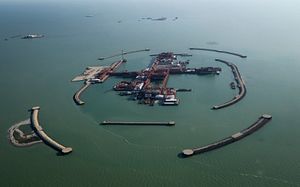On June 17, Kazakhstan’s Prime Minister Karim Massimov said the Kashagan oilfield will resume operations by the beginning of 2017 at the latest. This is a rare show of confidence by the Kazakhstani government towards the long-overdue project, which was supposed to change the game in Caspian energy geopolitics. When it was discovered in 2000, the Kashagan offshore field was the largest successful exploration venture of the previous three decades. Kashagan gave Kazakhstan confidence in the stability of its budget for the subsequent decades. The naming of the field after one of the most important poets in the country’s history, Kashagan Kurzhimanuly, was very deliberate. However, “kashagan” can also be translated as “unreachable, unattainable,” which ironically reflect the continuous delays.
Discounting a brief start of operations in September 2013, the giant oilfield is already a decade behind schedule. Its operations were first planned for 2005, but technical difficulties have pushed back the date for its first crude. This has been worrisome for both transnational energy companies investing in the project and for the government of Kazakhstan, anxious to reap the benefits from its offshore gem as the other fields in the country were depleting at a fast rate.
The North Caspian Operating Company (NCOC) is the consortium of companies that are developing the field. It has invested more than $50 billion in the project over the past 15 years (an overrun of $40 billion since the first quote). On June 9, Stéphane de Mahieu, managing director of NCOC, said output will resume in the second half of 2016 and, after a few months at 90,000 barrels per day (bpd), output will go up to 180,000 bpd in 2017, reaching the maximum capacity of 370,000 bpd at the end of 2017, concluding the first phase. Once the first phase is completed, “A decision will be taken then on implementing the second stage of development,” he told the government agency Kazinform.
The NCOC is formed by Eni, Royal Dutch Shell, Total S.A., ExxonMobil, KazMunayGas (each with 16.81 percent), China National Petroleum Corporation (8.4 percent), and Inpex (7.56 percent). Not all voices within the consortium partners agree to the timeline. In November 2014, Total SA’s chief of exploration and production Arnaud Breuillac said output would resume by 2017. In March this year, Royal Dutch Shell agreed that production will restart in 2017 given the replacement activities on the pipes, which are due to be completed by the end of 2017.
Kazakhstan’s president Nursultan Nazarbayev, meanwhile, is hoping for a faster recovery. “By the end of the year or in 2016 we hope to get some oil from the field” he said in a speech shortly after his re-election in April 2015. Nazarbayev added that Kazakhstan doesn’t need Kashagan to prosper: “The current oil production is enough. When delays like this happen, I always say that more will remain for our future generations.”
Amid delays and hopeful declarations, the reality is that when it began operations in September 2013, the pipes that brought the crude to the processing plants showed leaks. These leaks have proven impossible to repair and Italian firm Saipem was given another $1.8 billion contract to re-build the conduits. The new pipeline has to meet higher standards against corrosion and is said to cost around 10 times more than an ordinary pipeline.
Last March, during the presentation of its triennial strategy for the period to 2018, ENI was the first to count on Kashagan to resume operations in the second half of 2016, projecting the first oil on its balance sheets. So far, Kashagan has been a great, if virtual, asset for the companies involved in the consortium. The delays have allowed them to have a “projected income” from Kashagan each year and the companies have used capital expenditure in the project as a tool for the diversification of their portfolio. Cost overruns, however, have discouraged some companies, like ConocoPhillips, which opted out in 2013, and might become too great a burden for the others players who have been chasing the “unreachable” Kashagan dream.
































